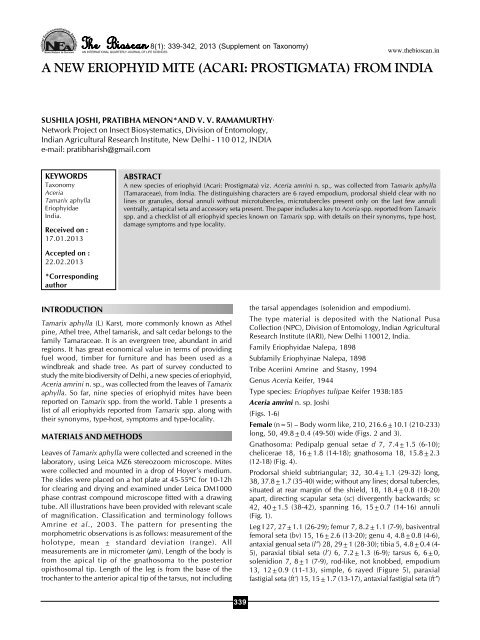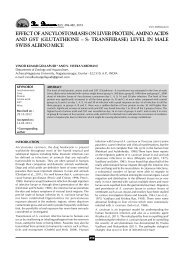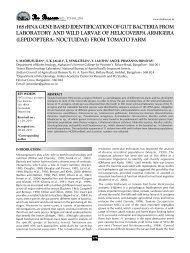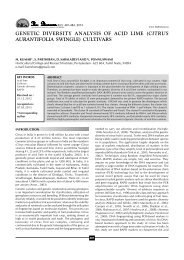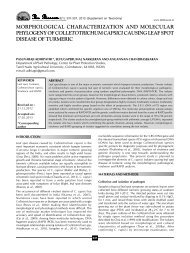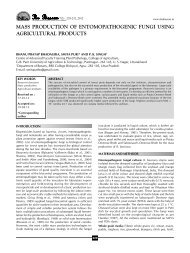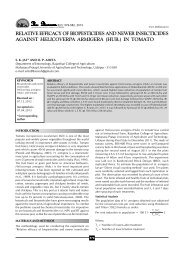A new Eriophyid mite (Acari: Prostigmata) from India - THE BIOSCAN
A new Eriophyid mite (Acari: Prostigmata) from India - THE BIOSCAN
A new Eriophyid mite (Acari: Prostigmata) from India - THE BIOSCAN
Create successful ePaper yourself
Turn your PDF publications into a flip-book with our unique Google optimized e-Paper software.
NSave Nature to Survive<br />
8(1): 339-342, 2013 (Supplement on Taxonomy)<br />
www.thebioscan.in<br />
A NEW ERIOPHYID MITE (ACARI: PROSTIGMATA) FROM INDIA<br />
SUSHILA JOSHI, PRATIBHA MENON*AND V. V. RAMAMURTHY ,<br />
Network Project on Insect Biosystematics, Division of Entomology,<br />
<strong>India</strong>n Agricultural Research Institute, New Delhi - 110 012, INDIA<br />
e-mail: pratibharish@gmail.com<br />
KEYWORDS<br />
Taxonomy<br />
Aceria<br />
Tamarix aphylla<br />
<strong>Eriophyid</strong>ae<br />
<strong>India</strong>.<br />
Received on :<br />
17.01.2013<br />
ABSTRACT<br />
A <strong>new</strong> species of eriophyid (<strong>Acari</strong>: <strong>Prostigmata</strong>) viz. Aceria amrini n. sp., was collected <strong>from</strong> Tamarix aphylla<br />
(Tamaraceae), <strong>from</strong> <strong>India</strong>. The distinguishing characters are 6 rayed empodium, prodorsal shield clear with no<br />
lines or granules, dorsal annuli without microtubercles, microtubercles present only on the last few annuli<br />
ventrally, antapical seta and accessory seta present. The paper includes a key to Aceria spp. reported <strong>from</strong> Tamarix<br />
spp. and a checklist of all eriophyid species known on Tamarix spp. with details on their synonyms, type host,<br />
damage symptoms and type locality.<br />
Accepted on :<br />
22.02.2013<br />
*Corresponding<br />
author<br />
INTRODUCTION<br />
Tamarix aphylla (L) Karst, more commonly known as Athel<br />
pine, Athel tree, Athel tamarisk, and salt cedar belongs to the<br />
family Tamaraceae. It is an evergreen tree, abundant in arid<br />
regions. It has great economical value in terms of providing<br />
fuel wood, timber for furniture and has been used as a<br />
windbreak and shade tree. As part of survey conducted to<br />
study the <strong>mite</strong> biodiversity of Delhi, a <strong>new</strong> species of eriophyid,<br />
Aceria amrini n. sp., was collected <strong>from</strong> the leaves of Tamarix<br />
aphylla. So far, nine species of eriophyid <strong>mite</strong>s have been<br />
reported on Tamarix spp. <strong>from</strong> the world. Table 1 presents a<br />
list of all eriophyids reported <strong>from</strong> Tamarix spp. along with<br />
their synonyms, type-host, symptoms and type-locality.<br />
MATERIALS AND METHODS<br />
Leaves of Tamarix aphylla were collected and screened in the<br />
laboratory, using Leica MZ6 stereozoom microscope. Mites<br />
were collected and mounted in a drop of Hoyer’s medium.<br />
The slides were placed on a hot plate at 45-55ºC for 10-12h<br />
for clearing and drying and examined under Leica DM1000<br />
phase contrast compound microscope fitted with a drawing<br />
tube. All illustrations have been provided with relevant scale<br />
of magnification. Classification and terminology follows<br />
Amrine et al., 2003. The pattern for presenting the<br />
morphometric observations is as follows: measurement of the<br />
holotype, mean ± standard deviation (range). All<br />
measurements are in micrometer (µm). Length of the body is<br />
<strong>from</strong> the apical tip of the gnathosoma to the posterior<br />
opisthosomal tip. Length of the leg is <strong>from</strong> the base of the<br />
trochanter to the anterior apical tip of the tarsus, not including<br />
the tarsal appendages (solenidion and empodium).<br />
The type material is deposited with the National Pusa<br />
Collection (NPC), Division of Entomology, <strong>India</strong>n Agricultural<br />
Research Institute (IARI), New Delhi 110012, <strong>India</strong>.<br />
Family <strong>Eriophyid</strong>ae Nalepa, 1898<br />
Subfamily Eriophyinae Nalepa, 1898<br />
Tribe Aceriini Amrine and Stasny, 1994<br />
Genus Aceria Keifer, 1944<br />
Type species: Eriophyes tulipae Keifer 1938:185<br />
Aceria amrini n. sp. Joshi<br />
(Figs. 1-6)<br />
Female (n=5) – Body worm like, 210, 216.6±10.1 (210-233)<br />
long, 50, 49.8±0.4 (49-50) wide (Figs. 2 and 3).<br />
Gnathosoma: Pedipalp genual setae d 7, 7.4±1.5 (6-10);<br />
chelicerae 18, 16±1.8 (14-18); gnathosoma 18, 15.8±2.3<br />
(12-18) (Fig. 4).<br />
Prodorsal shield subtriangular; 32, 30.4±1.1 (29-32) long,<br />
38, 37.8±1.7 (35-40) wide; without any lines; dorsal tubercles,<br />
situated at rear margin of the shield, 18, 18.4±0.8 (18-20)<br />
apart, directing scapular seta (sc) divergently backwards; sc<br />
42, 40±1.5 (38-42), spanning 16, 15±0.7 (14-16) annuli<br />
(Fig. 1).<br />
Leg I 27, 27±1.1 (26-29); femur 7, 8.2±1.1 (7-9), basiventral<br />
femoral seta (bv) 15, 16±2.6 (13-20); genu 4, 4.8±0.8 (4-6),<br />
antaxial genual seta (l”) 28, 29±1 (28-30); tibia 5, 4.8±0.4 (4-<br />
5), paraxial tibial seta (l’) 6, 7.2±1.3 (6-9); tarsus 6, 6±0,<br />
solenidion 7, 8±1 (7-9), rod-like, not knobbed, empodium<br />
13, 12±0.9 (11-13), simple, 6 rayed (Figure 5), paraxial<br />
fastigial seta (ft’) 15, 15±1.7 (13-17), antaxial fastigial seta (ft”)<br />
339
SUSHILA JOSHI et al.,<br />
Figsure1-6: Aceria amrini : 1. Dorsal shield design; 2. Lateral view<br />
showing all dorsal, ventral and lateral body setae; 3. Ventral view<br />
showing setae of leg I and II, coxal setae, genitalia, ventral body<br />
setae; 4. Lateral view of prodorsal shield showing setae of Leg I and<br />
II, scapular setae and lateral prodorsal shield design; 5. Enlarged<br />
view of tarsus I showing empodium, solenidion, u’, ft’ and ft’’; 6.<br />
Setae h1 and h2. Scale as depicted<br />
30, 30±0.4 (30-31), unguinal seta (u’) 9, 7.2±1.3 (6-9). Leg II<br />
24, 25±0.8 (24-26); femur 6, 6.4±1.1 (5-8); basiventral<br />
femoral seta (bv) 20, 15±3.3 (12-20); genu 4, 4.2±0.4 (4-5),<br />
antaxial genual seta (l”) 10, 10±0.7 (9-11); tibia 4, 4.6±0.5<br />
(4-5), paraxial tibial seta (l’) absent; tarsus 6, 5.8±0.4 (5-6),<br />
solenidion 7, 9±2.3 (7-13), rod like, not knobbed, empodium<br />
10, 9.6±0.9 (8-10), empodium simple, 6 rayed, ft’ 8, 8.5±1.3<br />
(7-10), ft” 28, 29±1.8 (28-32), u’ 5, 6.6±1.1 (5-8) (Figs. 3, 4).<br />
Coxal area smooth, coxisternal seta I (1b) 10, 10±0.4 (10-11),<br />
11, 10±0.7 (9-11) apart; coxisternal seta (1a) 30, 29±6.6 (18-<br />
35), 6, 6±0.7 (5-7) apart; coxisternal seta (2a) 38, 42±10 (32-<br />
56), 22, 22±0.5 (21-22) apart. Coxisternal area with two<br />
microtuberculate annulus (Fig. 3).<br />
Genitalia 15, 14±0.5 (14-15) wide, 15, 13±1.3 (12-15) long;<br />
epigynium without longitudinal ridges or markings, smooth;<br />
proximal seta on coxisternum III (3a) 60, 52±8.8 (41-60)<br />
(Fig. 3).<br />
Opisthosomal annuli continuous dorsoventrally. Lateral seta<br />
(c2) 60, 55±6.1 (45-60). Opisthosomal seta (d) 68, 63±8.6<br />
(50-70), 32, 31±1.1 (30-32) apart, on annulus 17, 16±1.3<br />
(14-17); opisthosomal seta (e) 45, 41±4.3 (34-45), 15, 13±1.5<br />
(12-15) apart, on annulus 31, 30±1.2 (28–31); opisthosomal<br />
seta (f) 55, 50±5.1 (45-55), 34, 33±3.6 (28-37) apart, on<br />
annulus 48, 47±1.7 (45-49). Dorsal annuli without<br />
microtubercles, total dorsal annuli 54, 53±1.8 (50-54); ventral<br />
annuli with small and slightly oval microtubercles present only<br />
<strong>from</strong> seta (f), total ventral annuli 53, 53±1.9 (50-55).<br />
Opisthosomal seta (h2) 130, 124±14 (100-135); seta (h1) 4,<br />
4.8±0.8 (4-6) (Fig.s 2, 3,6).<br />
Male – Unknown.<br />
Holotype – Female, INDIA: I.A.R.I, New Delhi, 03 Nov. 1989,<br />
ex: Tamarix aphylla (Tamaraceae), Coll. Sushila Joshi,<br />
deposited with N.P.C., I.A.R.I., New Delhi.<br />
Paratypes: Collection data same as above. 5 female on 5<br />
microscopic slides.<br />
Distribution: <strong>India</strong>: New Delhi.<br />
Relationship with host plant – These <strong>mite</strong>s were collected<br />
<strong>from</strong> the stem, leaves and buds of Tamarix aphylla, no apparent<br />
damage to host plant was observed.<br />
Etymology – The specific name amrini is in honour of Dr.<br />
James Amrine, West Virginia University, in recognition of his<br />
contributions to Acarology in general and <strong>Eriophyid</strong>ae in<br />
particular.<br />
Remarks – The <strong>new</strong> species is characterized and distinguished<br />
<strong>from</strong> a more similar Aceria tamaricis (Trotter) in the absence<br />
of microtubercles, presence of 6 rayed empodium, prodorsal<br />
shield without any lines or median pit. A key to species of the<br />
genus Aceria reported on Tamarix sp. is provided as follows:<br />
Key to Aceria spp. reported on Tamarix spp.<br />
1. Empodium 5-6 rayed.......................................................… 2<br />
Empodium with 6 or more rays..............................................3<br />
2. Prodorsal shield with median and admedian lines;<br />
submedian lines absent opisthosomal rings nonmicrotuberculate;<br />
empodium 5<br />
rayed…………………........................…. tlaiae (Trabut, 1917)<br />
Prodorsal shield with median, admedian and submedian<br />
lines present; empodium 5-6<br />
rayed...................................................... arbosti (Cotte, 1924)<br />
3. Empodium 6 rayed; prodorsal shield without median,<br />
admedian and submedian lines; opisthosomal rings nonmicrotuberculate………………………………….<br />
amrini n. sp.<br />
Empodium more than 6 rayed .........................................4<br />
4. Empodium 7 rayed; prodorsal shield lack central lines,<br />
curved lines and short median present at rear margin of<br />
shield between dorsal tubercles; opisthosomal rings with<br />
rounded microtubercles………….…dioicae (Keifer, 1979)<br />
Empodium 7-8 rayed in protogyne, 8-9 rayed in deutogyne;<br />
prodorsal shield without median, admedian and submedian<br />
lines; small pit centrally located on the rear shield margin;<br />
opisthosomal rings with elliptical microtubercles…… tamaricis<br />
(Trotter, 1901)<br />
ACKNOWLEDGEMENTS<br />
The authors are grateful to Dr. James W. Amrine, West Virginia<br />
University, USA for his confirmation on the material and for<br />
providing the <strong>new</strong> species status through examination of the<br />
material and providing useful comments on its description.<br />
The authors thank Ms. Luvlesh Rawat for rendering her efforts<br />
in setting images in photoshop. Also, literature support<br />
provided by Dr. Mariuz Lewandowski, Warsaw Agricultural<br />
University, Poland; Dr. Debra Creel, ARS, USDA, Dr. De Lillo,<br />
University of Bari, Italy is gratefully acknowledged. The authors<br />
340
A NEW ERIOPHYID MITE<br />
Table 1: List of eriophyid <strong>mite</strong>s collected <strong>from</strong> Tamarix spp.<br />
Species Host Symptom Type locality<br />
Aceria amrini n. sp. Tamarix aphylla Collected <strong>from</strong> stem, leaves I.A.R.I., New Delhi, <strong>India</strong><br />
and buds with no apparent<br />
damage to host.<br />
Aceria arbosti (Cotte) Tamarix africana Poir Twig and leaf deformation. Gorge of St. Andre, route<br />
Eriophyes arbosti Cotte, 1924:7 de falicon, Provence, France.<br />
Aceria arbosti (Cotte): Castagnoli, 1992:447<br />
Aculus arbosti (Cotte): Amrine & Stasny 1994:134<br />
Aceria dioicae (Keifer) Tamarix dioica Roxb., Tamarix ericoides Bud gall, galls Wazirabad, Pakistan, Egypt,<br />
Eriophyes dioicae Keifer, 1979:5 Rottl., Tamarix hispida Willd., Tamarix Iran, <strong>India</strong>, Israel<br />
Aceria dioicae (Keifer): Castagnoli, 1992:447;Amrine & Stasny 1994:42 nilotica (Ehrenb.) Bung., Tamarix<br />
Eriophyes synchytrioides Dcbski, 1918:26; tetragyna Ehrenb., Tamarix ericoides Rottl.,<br />
Abou-Awad & Borolossy 1995: 146 Tamarix hispida Willd.<br />
Aceria tamaricis (Trotter) Tamarix sp.,Tamarix chinensis Lour., Cause twig knots, 4-8 mm long, Cecidotheca Italica, Lake<br />
Eriophyes tamaricis Trotter, 1901:953; Trotter & Cecconi, 1904:289 Tamarix gallica L., Tamarix ramosissima, galls are green, soft, like small Isnik near Bazarkioi, Asia<br />
Aceria tamaricis (Trotter): Castagnoli, 1992:447; Amrine & Stasny 1994:90 T. smirnensis Bunge. tunnels on the young branches. Minor, Turkey,; Thessaloniki,<br />
In time, the galls turn light red to Greece, China France<br />
brown and get harder<br />
Aceria tlaiae (Trabut) Tamarix articulata Vahl Irregularly round galls. Appears Takout, Morocco, Algiers,<br />
Eriophyes tlaiae Trabut, 1917:29; De Bergevin, 1917:94 as a large protuberance on young <strong>India</strong>, Israel, Morocco,<br />
Aceria tlaiae (Trabut,): Castagnoli, 1992:447; Amrine & Stasny 1994:92 green branches or at their apex. Pakistan<br />
Size <strong>from</strong> a few mm in diameter<br />
to 10 x 25 mm<br />
Eriophyes strobilobius Dcbski<br />
Eriophyes strobilobius Dcbski, 1918:25: Amrine & Stasny 1994:216 Tamarix nilotica (Ehrenb.) Bung. Galls Egypt<br />
Eriophyes tetragynae Dcbski<br />
Eriophyes tetragynae Dcbski, 1918:27: Amrine & Stasny 1994:215 Tamarix tetragyna Ehrenb. Galls Egypt<br />
Vasates immigrans (Keifer)<br />
Phyllocoptes immigrans Keifer, 1940:29; Mohanasundaram 1982:419<br />
Aculops immigrans (Keifer): Keifer 1967:4<br />
Vasates immigrans (Keifer): Keifer 1952:45; Davis et al., 1982:169; Tamarix gallica L., Tamarix plumosus L. The <strong>mite</strong>s were under scale-like Sacramento, California, USA;<br />
Amrine & Stasny 1994:309 leaves and on stems. <strong>India</strong>, Poland<br />
Dicruvasates tamaricis Abou-Awad & El-borolossy, 1995:145 Tamarix nilotica (Ehrenb.) Bung. Vagrant preferring twigs El-fayum, Egypt.<br />
and causing rusting.<br />
are grateful to ICAR for funding<br />
Network Project on Insect<br />
Biosystematics.<br />
REFERENCES<br />
Abou-Awad, B. A. and El-borolossy, M.<br />
A. 1995. Two eriophyid <strong>mite</strong>s on tamarisk<br />
trees in Egypt (<strong>Acari</strong>: Eriophyoidea:<br />
<strong>Eriophyid</strong>ae). Acarologia. 36(2): 145-148.<br />
Amrine, J. W. Jr. and Stasny, T. A. 1994.<br />
Catalog of the Eriophyoidea (<strong>Acari</strong>na:<br />
<strong>Prostigmata</strong>) of the world. Indira<br />
Publishing Houses, W. Bloomfield,<br />
Michigan, USA: Publisher. p. 798.<br />
Amrine, J. W. Jr., Stasny, T. A. and<br />
Flechtmann, C. H. W. 2003. Revised keys<br />
to world genera of Eriophyoidea (<strong>Acari</strong>:<br />
<strong>Prostigmata</strong>). Indira Publishing Houses,<br />
W. Bloomfield, Michigan, USA:<br />
Publisher. p. 244.<br />
Castagnoli M. 1992. Redescription of<br />
Aceria tamaricis (Trotter, 1901) (<strong>Acari</strong>:<br />
<strong>Eriophyid</strong>ae). Redia. 75(2): 447-452.<br />
Cotte, J. 1924. Les cecides des Alpes<br />
Maritimes et leurs producteurs. Mem.<br />
Soc. Linneenne de Provence. 3: 1-56.<br />
Davis, R., Flechtmann, C. H. W., Boczek,<br />
J. H. and Barke, H.E. 1982. Catalogue of<br />
<strong>Eriophyid</strong> <strong>mite</strong>s (<strong>Acari</strong>: Eriophyoidea).<br />
Warsaw Agricultural University Press,<br />
Warsaw, Poland: Publisher. p. 254.<br />
Dcbski, B. 1918. Liste des cecides signalees<br />
en Egypte jusqu’a ce jour. Mem. Soc.<br />
Entomol. Egypte. 1(4):1-37.<br />
De Bergevin, E. 1917. Remarks on the<br />
galls caused by Eriophyes tlaiae on<br />
Tamarix articulate. Bull. Soc. Hist. Nat.<br />
Afr. Nord, Algiers. 8(4): 94-95.<br />
Keifer, H. H. 1938. <strong>Eriophyid</strong> studies I.<br />
Bull. Dept. Agric. Calif. 27:181-206.<br />
Keifer, H. H. 1940. <strong>Eriophyid</strong> studies VIII.<br />
Bull. Dept. Agric. Calif. 29: 21-46.<br />
Keifer, H. H. 1944. <strong>Eriophyid</strong> studies XIV.<br />
Bull. Dept. Agric. Calif. 33:18-38.<br />
Keifer, H. H. 1952. The <strong>Eriophyid</strong> <strong>mite</strong>s<br />
of California (<strong>Acari</strong>na, <strong>Eriophyid</strong>ae). Bull.<br />
Calif. Insect Survey. 2(1): 1-123.<br />
Keifer, H. H. 1967. Reference list, general<br />
index, host index. Special Publication.<br />
California Department of Agriculture:<br />
Publisher. p.12.<br />
Keifer, H. H. 1979. <strong>Eriophyid</strong> studies C-<br />
16. Agricultural Research Service, U.S.<br />
Deptt. of Agriculture: Publisher. p. 24.<br />
Mohanasundaram, M. 1982. New species<br />
and records of gall <strong>mite</strong>s (<strong>Acari</strong>na:<br />
<strong>Eriophyid</strong>ae) <strong>from</strong> Tamil Nadu, <strong>India</strong>.<br />
Orient. Insects. 16(4): 419-429.<br />
Nalepa, A. 1898. Zur Kenntniss der<br />
Gattung Trimerus Nal. Zool. J. 11: 405.<br />
Trabut 1917. La galle du Tamarix articulate<br />
341
SUSHILA JOSHI et al.,<br />
dite Tak’out au Maroc. Bull. Soc. Hist. Nat. Afrique Nord. 3: 29-30.<br />
Trotter, A. 1901. Di una nuova specie d’Acaro (Eriophyes) d’ Asia<br />
Minore produttore di galle su Tamarix. Atti R. Ist. Ven. Sci. Lett. Ed<br />
Aeti. 60(2): 953-955.<br />
Trotter, A. and Cecconi, G. 1904. Cecidotheca Italica. Avellino, fasc.<br />
12: 289.<br />
342


